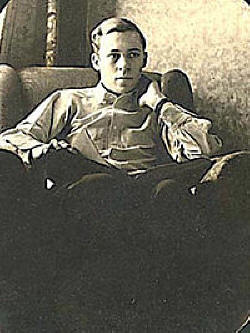

Queer Places:
The Dalton School, 108 E 89th St, New York, NY 10128, Stati Uniti
Gertrude Rhinelander Waldo House, 867 Madison Ave, New York, NY 10021, Stati Uniti
Quiet Corner, 12 Hill Rd, Greenwich, CT 06830, USA
Little Church Around the Corner, 1 E 29th St, New York, NY 10016, Stati Uniti
 Edgar Domingo Evia y Joutard,[1] known professionally as Edgar de Evia (July 30, 1910 – February 10, 2003), was a Mexican-born American interiors photographer.
Edgar Domingo Evia y Joutard,[1] known professionally as Edgar de Evia (July 30, 1910 – February 10, 2003), was a Mexican-born American interiors photographer.
In a career that spanned the 1940s through the 1990s, his photography appeared in magazines and newspapers such as ' ''House & Garden'', ''Look'' and ''The New York Times Magazine'' and advertising campaigns for Borden Ice Cream and Jell-O.
In 1942, homeopathic physician Guy Beckley Stearns and Edgar D. Evia contributed an essay called "''The New Synthesis''", For the ''Laurie's Domestic Medicine'' medical guide.[2]
In a review of the book, ''The New York Times'' stated that "Black and white [photography] is frequently interspersed through the book and serves as a reminder that black and white still has a useful place, even in a world of color, often more convincingly as well. This is pointed up rather persuasively in the portfolio on Edgar de Evia as a 'master of still life' and in the one devoted to the work of Réne Groebli."[3] "Editorial high-key food photography was introduced by Edgar D'Evia in 1953 for the pages of ''Good Housekeeping''."[4]
Melvin Sokolsky, a fashion photographer who has created images for Harpers Bazaar and Vogue, considered Edgar de Evia one of his earliest influences, saying, "I discovered that Edgar was paid $4,000 for a Jell-O ad, and the idea of escaping from my tenement dwelling became an incredible dream and inspiration."[5]
Gertrude Rhinelander Waldo House, New York City
De Evia also produced commissioned photographic portraits of individuals, including Polish-American violinist Roman Totenberg [6] and the American fashion designer Ralph Lauren.[7]
De Evia's work appeared on ''Applied Photography'',[8] [9] ''Architectural Digest'',[10] ''Good Housekeeping'',[11] ''Shaggy Lamb Fashion'',[12] and ''New York Magazine''.[13]
De Evia worked for Borden Ice Cream (Lady Borden campaign 1956–1960),[14] Celanese Corporation,[15] Gorham Silver,[16] hats by Mr. John of John-Frederics,[17] Leather Industries of America,[18] Maximilian Furs (1950s, all ads had the credit "DeEvia"), McCall's patterns (all ads had the credit "Photograph by Edgar de Evia").[19]
Church of the Transfiguration and Rectory, New York City
In the 1950s, de Evia's companion and business partner was Robert Denning, who worked in his studio and who would become a leading American interior designer and partner in the firm Denning & Fourcade.[20]
My published books:
https://en.wikipedia.org/wiki/Edgar_de_Evia